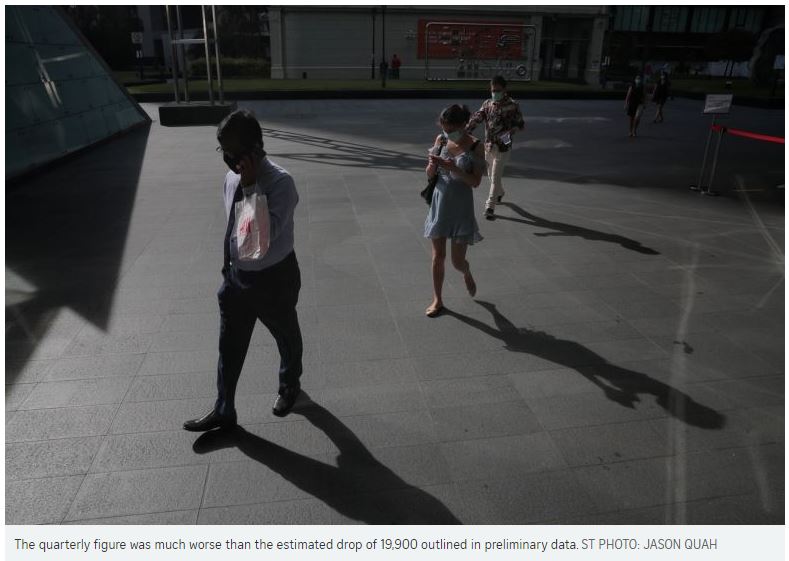Singapore’s total employment sees biggest decline ever in first quarter
SINGAPORE – The fall in the number of people employed here as at end-March compared with the end of last year was the largest decline recorded and there’s worse to come, the Ministry of Manpower said on Monday (June 15).
The number of people working, excluding maids, fell by 25,600 in the three months to March 31 this year – the biggest quarterly contraction on record.
Much of the decline was due to significant cutbacks in the number of foreign workers but local employment also dropped slightly due to a sharper-than-expected fall in headcounts in trade and tourism-related industries, said the ministry in its labour market report for the first quarter.
It did not provide a breakdown of the exact numbers of locals and foreigners employed; data by residential status is only usually available in the half-yearly report.
The quarterly figure was also much worse than the estimated drop of 19,900 outlined in preliminary data.
Retrenchments also increased over the quarter, while the seasonally adjusted number of job vacancies fell to the lowest level since September 2010.
But the employment situation has yet to hit rock bottom as the circuit breaker measures only kicked in during the second quarter.
Manpower Minister Josephine Teo said: “In January, there was still a lot of new year festivities… In February, tourism was already quite badly hit, but the further travel restrictions that we see today had not yet started.
“In other words, the full effects of Covid-19 certainly have not been felt in the first quarter.”
Employment declines were sharpest in sectors such as food and beverage, retail trade, wholesale trade, accommodation and arts, entertainment and recreation. Construction and manufacturing also saw drops, which mostly affected foreign workers.
These declines outstripped employment gains in industries such public administration and education and professional and financial and insurance services.
Such contraction in headcount across sectors is also evident using a new indicator, known as the employment diffusion index, which measures how widespread employment change is.
The indicator stands at 38.7 last quarter, which means more industries cut employment than those that increased their payrolls.
This figure was 55.7 in December, when more industries were expanding headcounts.
Unemployment rates for citizens rose to 3.5 per cent in March this year, from 3.3 per cent in December, after accounting for seasonal variations.
The rate for residents was 3.3 per cent, up from 3.2 per cent.
Total unemployment stood at 2.4 per cent, still well under the previous high of 4.8 per cent in September 2003 following the Severe Acute Respiratory Syndrome (Sars) crisis.
Around 3,220 workers were laid off in the first quarter compared with the 2,670 in the last quarter of 2019.
There were 1,537 local employees affected by their companies shutting down from January to March, compared with 628 in the fourth quarter of last year.
Meanwhile, seasonally adjusted job vacancies fell from 52,700 in December last year to only 46,300 as of March.
The seasonally adjusted ratio of vacancies to unemployed persons also hit a decade low of 0.71. This means that there were only seven job openings for every 10 jobseekers.
Mrs Teo added that although overall job vacancies fell, there were more openings in sectors like electronics manufacturing and health and social services.
She also noted that Government measures like the Jobs Support Scheme have provided some help to companies, preventing the unemployment rate or retrenchments to spike sharply.
“Instead of retrenchments, we saw a five-fold increase in the number of employees that were placed on shorter work weeks or temporary lay-offs… (which) suggests measures that are supported by tripartite partners (are working). Although they involve some sacrifices on the part of the workers, they are also helping to preserve jobs,” she said.
Around 4,000 employees were placed on new arrangements that involved working shorter weeks or being temporarily laid off in the first quarter compared with the 840 in the last quarter in 2019.
There was also a fall in the average weekly total paid hours worked, from 44.7 in December to 44.4 hours in March, with an average of 2.4 hours of paid overtime a week.
Mrs Teo said: “We do not know exactly how the second quarter will turn out but it is best for us to get ready and be prepared for more job losses and we have to try our very best to open up more pathway for job seekers.”
These pathways include traineeships for fresh graduates and mid-career professionals, to help them boost their resumes even when companies might not be ready to hire them full-time due to the uncertain economic outlook, she added.

Source: https://www.straitstimes.com/singapore/manpower/singapores-total-employment-sees-biggest-decline-ever-in-first-quarter


 English
English




